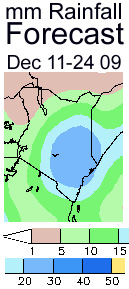Nairobi’s Daily Nation newspaper claimed Thursday that the drought was continuing. That the ground was parched; that crops were destroyed; that famine was everywhere. This burns me up.
Within a day, of course, media around the world picked up the story. I found it in the Zanesville, Ohio Times Register. My god is there no fact checking, anymore?
Below I have documented by weather satellite the real story. But before discussing that, I think we need to wonder why one of Nairobi’s great newspapers was so inaccurate.
1 – East Africa weather reporting is awful. I worked for a while with the man from the University of Nairobi who was responsible for retrieving the (then) printed data from the machine near Mt. Kenya for Nanyuki area weather. He was supposed to have organized it daily; he made it about once a month.
Hopefully, today, it’s digital, but the facts continue to suggest there is very poor reporting. In fact, what the facts are suggesting right now is a bit more onerous than just poor reporting.
Of nine Kenyan weather stations that are supposed to report back to NOAA (the U.S.’ “National Oceanographic and Atmospheric Administration”), the only ones that reported back since October are stations where the rainfall was less than normal: Marsabit, Meru, Mombasa, etc.
Nairobi where rainfall has been between 200-300% of normal — the most important reporting station in the country — didn’t report! Or Kisumu, where it was flooding!
Is someone trying to skew… no, I better not say that. How terrible of me to think such a thing.
(Who cares if Kenya reports to NOAA? Anyway! That’s supposedly Kenya’s payback for getting good weather data provided by NOAA’s satellite.)
2 – Equatorial climates have always been, and will continue to get more erratic with global warming. In short reporting intervals, there is never any uniform rainfall pattern in the tropics. There are small areas of very heavy rain right next to small areas of drought.
But more and more there are growing population centers spreading across every arable bit of the tropics, and over the boundaries between drought and no-drought. No-drought is not a news story. Drought is.
3 – African populations are becoming stressed beyond belief in even the best of times. Kenya just came out of terrible political turmoil followed by very little rain for nearly three years. Each exacerbated the other.

NOAA’s satellite shows the October – December, traditionally north and east of Nairobi as the period of “Short Rains” as being normally erratic, with about a third of the country receiving less than 70% of normal rains, but with nearly a third receiving almost twice as much rain as normal, and the remainder third around normal on the heavy side.
The graph to the right can be better explained by removing the areas where rainfall was better than 70%, and leaving marked only those areas where rainfall was 70% or less.
Less than 70% rains is a condition of climate stress, although not drought by any means, and the fact that there was such a large fraction of the country in this deficit is terrible. But it’s not unusual. There can be floods next to droughts in short intervals, remember? For the country as a whole because so many parts received so much rain, the graph of precipitation for the area as a whole for the last quarter of 2009 is … utterly normal.
We would have liked torrents, everywhere. But… it was normal.
The story is hardly over. El Nino might or might not play out. Every drop of water deficit in Africa today results in growing tragedy and that’s the ultimate lesson to be learned from this: what is normal in terms of rainfall over the last century in Africa may be life-threatening by current population needs.
But skewering the facts and exaggerating the bad to evince this position might do just the opposite. No one will know what to believe. Rather than blaming over-population, or egregious neglect by the developed world, we blame the weather.
There’s nothing we can do about the weather… right now.
The Daily Nation said Thursday that Kenyan meteorologists considered that El Nino would not occur and that the rains would all end shortly over the whole country.
WASHINGTON — (Associated Press, Dec 10) : The El Nino climate phenomena has strengthened and is expected to last into spring, potentially affecting weather around the globe for the next few months, the government said Thursday…

That “government” the AP refers to is NOAA, which put out a number of releases and graphs about El Nino this morning.
And the forecast for next two weeks is for pretty heavy rain. Nearly countrywide.
Green represents normal precipitation for this time of the year; blue, more than normal. It’s going to be a rainy Christmas. And for the entire next rainy season, March – May, NOAA is currently predicting a very average season, with the possibility that a strengthening El Nino could make it wetter than normal.
My days as a weatherman are numbered. But this data is available for everyone, including The Daily Nation, Kenyan politicians and those spineless naysayers that wittingly or otherwise shift blame for Kenya’s ills onto the … weather.